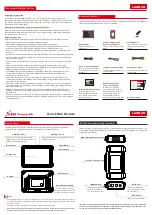
80
Crossover Parameters
•
“BAND NAME” LP FREQUENCY
[16 Hz - 20 kHz, OUT]
Adjusts the cutoff frequency of the low-pass filter.
•
“BAND NAME” LP TYPE
[BW 6, BW 12, BW 18, BW 24, BW 30, BW 36, BW 42, BW 48, LR 12, LR 24, LR 36, LR 48]
Selects the low-pass filter type and slope rate. BW stands for Butterworth. When two Butterworth filters are summed, a
3 dB increase in level will be created at the crossover frequency. LR stands for Linkwitz-Riley. When two Linkwitz-Riley
filters are summed, there is no increase in level around the crossover frequency, which makes these type of filters very
popular. The numbers next to each option represent the filter slope rate in dB per octave.
•
“BAND NAME” GAIN
[-60 dB to +20 dB]
Adjusts the output gain for the selected band.
•
“BAND NAME” POLARITY
[NORMAL, INVERTED]
Inverts the polarity of the selected band. Polarity inversion is used to match driver polarity in systems which require
it. See
‘Manually Optimizing A System Using The VENU360’ on page 44
for more information on polarity
inversion.
•
“BAND NAME” PHASE
[-180 deg - 0 deg]
This parameter utilizes an all-pass filter to adjust the phase of the signal at the LPF filter frequency by the number of
degrees indicated. This parameter only needs to be adjusted when utilizing bands containing both a high and low-pass
filter, such as a mid band in a 3-way crossover, or when a high-pass filter is engaged on a subwoofer crossover band
to filter out subsonic frequencies. This adjustment is useful for correcting the positive phase shift caused by the band’s
high-pass filter and allows the phase of the signal to be realigned at the crossover point (the low-pass filter frequency).
Correcting for this phase anomaly will improve coherence within the crossover overlap regions. See
‘Manually
Optimizing A System Using The VENU360’ on page 44
for more information on using this parameter.
•
“BAND NAME” HP FREQUENCY
[OUT, 16 Hz - 20 kHz]
Adjusts the cutoff frequency of the high-pass filter.
•
“BAND NAME” HP TYPE
[BW 6, BW 12, BW 18, BW 24, BW 30, BW 36, BW 42, BW 48, LR 12, LR 24, LR 36, LR 48]
Selects the high-pass filter type and slope rate. BW stands for Butterworth. When two Butterworth filters are summed, a
3 dB increase in level will be created at the crossover frequency. LR stands for Linkwitz-Riley. When two Linkwitz-Riley
filters are summed, there is no increase in level around the crossover frequency, which makes these type of filters very
popular. The numbers next to each option represent the filter slope rate in dB per octave.
Summary of Contents for DriveRack VENU 360
Page 1: ...Owner s Manual ...
















































